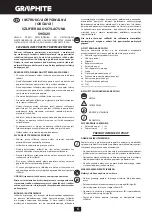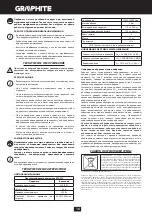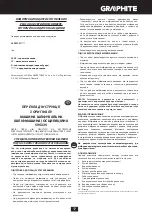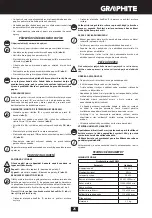
11
•
In case of excessive commutator sparking, have the technical
condition of carbon brushes of the motor checked by a qualified
person.
•
Always store the tool in a dry place, beyond reach of children.
REPLACEMENT OF CARBON BRUSHES
Immediately replace worn out (shorter than 5 mm), burnt or
cracked motor carbon brushes. Always replace both carbon
brushes at a time.
Entrust replacement of carbon brushes only to a qualified
person. Use only original parts.
All defects should be repaired by service workshop authorized by
the manufacturer.
TECHNICAL PARAMETERS
RATED PARAMETERS
Finishing Sander 59G325
Parameter
Value
Supply voltage
230 V AC
Power supply frequency
50 Hz
Rated power
300 W
Range of spindle rotational speed without
load
6000-12000 rpm
Oscillations per minute
12000-24000 rpm
Oscillation travel
2 mm
Size of backing pad
115 x 230 mm
Size of sanding paper
115 x 280 mm
Protection class
II
Weight
2,1 kg
Year of production
2018
59G325 defines type and indication of the device
NOISE LEVEL AND VIBRATION PARAMETERS
Sound pressure
Lp
A
= 85,8 dB(A) K= 3 dB(A)
Sound power
Lw
A
= 96,8 dB(A) K= 3 dB(A)
Vibration acceleration
a
h
= 5,515 m/s
2
K= 1,5 m/s
2
Noise and vibration information
Noise produced by the device is defined with: level of produced
sound pressure Lp
A
and level of sound power Lw
A
(where K is
measurement uncertainty). Vibrations produced by the device
are defined with vibration acceleration value a
h
(where K is
measurement uncertainty).
Sound pressure Lp
A
, sound power Lw
A
and vibration acceleration a
h
specified in this manual have been measured in accordance with the
standard EN 62841-1:2015.
Specified vibration level a
h
can be used to compare tools and for
initial evaluation of exposition to vibrations.
Specified vibration level is representative for main applications
of the device. When the device is used for other purposes or with
different working tools, the vibration level may change. Insufficient
or too rare maintenance may increase vibration level. The
abovementioned factors may lead to higher exposure to vibrations
during whole working time.
To precisely define exposure to vibrations, include periods
when the device is switched off and when it is switched on
but not used for working. Once all factors have been carefully
considered, total exposition to vibrations may be significantly
lower.
To protect the user from results of exposure to vibrations, use
additional safety measures such as: device and working tool periodic
maintenance, proper hand temperature conditions, good work
organisation.
INSTALLATION / REMOVAL / CLEANING OF THE DUST CON-
TAINER
•
Press the installation button (
9
) and slide out the dust container
(
5
) backwards (
fig. D
).
•
Press the cover locking buttons (
11
) on both sides and take off the
dust container cover (
10
) (
fig. E
).
•
Remove the filter (
12
), clean it and remove the dust from the
container (
10
) (
fig. F
).
•
Install all parts in reversed sequence of disassembly.
•
Slide the dust container (
10
) fully in, until the installation button
snaps (
9
) (
fig. G
).
•
Pull the dust container gently to make sure it is fixed securely.
It is recommended to empty the container when it is half-full.
OPERATION / SETTINGS
SWITCHING ON / OFF
The mains voltage must match the voltage on the rating plate
of the sander.
Switching on
– slide the switch (
3
) forward to position
I
.
Switching off
– slide the switch (
3
) backward to position
O
(
fig. H
).
OSCILLATION SPEED CONTROL
You can control the speed of sander oscillation by turning and
setting the control wheel (
1
) in desired position. It allows to adjust
the power tool working speed to match characteristics of processed
material. Speed control range is 1 to 6.
The greater the number on the wheel rim (1) (fig. I), the greater the
sander operation speed.
•
Increase the oscillation speed by turning the wheel (
1
) left.
•
Reduce the oscillation speed by turning the wheel (
1
) right.
Set up the right oscillation speed only when the sander is
working. Oscillation speed with load may be lower than the
speed set with no load.
WORKING WITH FINISHING SANDER
•
When operating, hold the finishing sander firmly with both hands
by the main handle (
4
) and the front handle (
2
).
•
Whole sanding area must rest on the processed surface.
•
Turn the sander on, apply moderate pressure and move it on the
processed material.
•
When about to finish sanding, reduce pressure and lift the sander
above the processed surface and only then you can switch off the
tool.
OPERATION AND MAINTENANCE
Disconnect the tool from power supply network before starting
any regulation, maintenance or repair.
MAINTENANCE AND STORAGE
•
Cleaning the device after each use is recommended.
•
Do not use water or any other liquid for cleaning.
•
Clean the device with a dry cloth or blow through with
compressed air at low pressure.
•
Do not use any cleaning agents or solvents, since they may
damage plastic parts.
•
Clean ventilation holes in the motor casing regularly to prevent
device overheating.
•
In case of power cord damage replace it with a cord with the same
specification. Entrust the repair to a qualified specialist or return
the tool to a service point.
Содержание 59G325
Страница 2: ...2...
Страница 4: ...4 1 2 3 4 7 6 5...
Страница 5: ...5 A 6 7 B 8 7 C 7 6 D 5 9 PRESS E 10 11 11 5 F 10 12 5 G 5 9 H 3 3 4 I 1...
Страница 15: ...15 II 1 2 3 4 5 6 7 8 9 10 11 12 1 1 2 1 6 A 7 8 6 B 5 C 5 9 5 D 10 11 E 12 10 F 10 9 G 3 I 3 0 H 1 1 6 1 I 1 1...
Страница 18: ...18 10 9 G 3 I 3 0 H 1 1 6 1 I 1 1 4 2 1 1 2 1 6 A 7 8 6 B 5 C 5 9 5 D 10 11 E 12 10 F...
Страница 38: ...38 1 1 2 1 6 A 7 8 6 B 5 5 9 5 D 10 11 E 12 10 F 10 9 G 3 I 3 0 H 1 1 6 1 I 1 1 4 2...
Страница 45: ...45 1 1 2 1 6 A 7 8 6 B 5 C 5 9 5 D 10 11 E 12 10 F 10 9 G 3 I 3 0 H 1 1 6 1 1 1 4 2...
Страница 54: ...54...
Страница 55: ...55...
Страница 56: ......












































